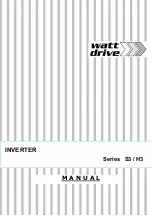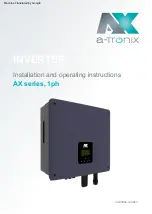
5.0 INSTALLATION
The inverter will provide you with up to 1000 watts of continuous, elec-
trical power (2000 watts peak) at 110 VAC when powered by a 12 VDC
source such as is found in a vehicle or multiple battery configuration as
shown in
FIGURE 7
. This manual does not describe all of the possible types
of battery configurations, battery charging configurations and battery isola-
tion configurations.
5.1 INPUT POWER REQUIREMENTS:
To properly operate the inverter the DC power source must provide
between 11.0 and 15.0 VDC and nominally at 100 Amps. This DC power
source must be a well-regulated DC power supply as typically found in
vehicular and deep-cycle marine batteries. The DC power source may also
be two 12 volt batteries connected in parallel. On larger applications the
power source may be several batteries connected in parallel as shown on
F
IGURE 7
.
Figure 7
–Battery Wiring
NOTE:
Vector
™
Manufacturing recommends that for typical heavy-duty
uses, a ANL-200 or equivalent (capable of handling 200 amps for a few
seconds) main buss fuse be added to the power source positive cable as
close as possible to the power source (battery) positive terminal. The fuse
amperage must be sized to allow simultaneous operation of all the AC
appliances to be powered, with delay characteristics that allow for the
momentary high start-up current requirements of inductive loads. Use the
recommended fuse block (fuse holder) and fuse, or an electrical equivalent.
For full rated output and motor start-up surge output, ensure that the installation
is configured to handle the full load.
Figure 7
is also used as a guide when the
cables are measured for installing the inverter. Available through Vector
Technical Support at (954) 584-4446 Ext. 119.
+
–
BATTERY
FUSE
200 AMP
FUSE HOLDER
+
–
+
–
BATTERY
+
–
BATTERY
+
–
BATTERY
BATTERY CHARGING
FROM COMMERCIAL
AC, ENGINE, SOLAR, ETC.
MAXX 1000
POWER
INVERTER
(Max of 4 Feet of
#4 AWG Wire)
Fuse To Battery Length
+ Fuse To Inverter Length
(Max of 4 Feet of #4 AWG Wire)
B. Input Voltage
The inverter will operate from input voltages between 10.5 and 15 VDC. If
the voltage drops below 10.6 volts, an audible low battery warning alarm
will sound. The inverter will shut down if the input voltage drops below 10.5
VDC. This built-in feature protects the battery from being completely
discharged.
The inverter will also shut down if the input voltage exceeds 15 volts This
protects the inverter against excessive input voltage. Although the inverter
has built-in protection against overvoltage, it may still be damaged if the
input voltage exceeds 15 volts.
NOTE:
Exceeding the recommended voltage limits will void the manufac-
turer’s warranty.
Inductive loads, such as TVs and stereos, require more current to operate
than do resistive loads with the same wattage rating. Induction motors, as
well as some TVs, may require two to six times their rated wattage to start
up. Because MAXX SST™ 1000 Model inverter have a peak power rating
of 2,000 watts, many such appliances and tools may safely be operated.
The equipment that needs the highest starting wattage are pumps and compres-
sors that start under load.
This equipment can be safely tested. If an overload is detected, the
inverters will simply shut down until the overload situation is corrected. Use
the front panel switch to turn OFF the inverter then ON to reset the inverter.
CAUTION:
NO USER-SERVICEABLE COMPONENTS INSIDE. OPENING UNIT
WILL VOID WARRANTY.
4.2 DETERMINING BATTERY SIZE:
To determine the minimum battery size that you will need to operate appli-
ances from the MAXX SST™ 1000 Models, follow these steps:
1. Determine the wattage of each appliance and/or tool you will need to
simultaneously operate from the inverter. To do this, read the labels on
the equipment to be operated. Usually, power consumption is shown in
watts. If it is shown in amps, multiply by 110 to determine the wattage.
2. Estimate the number of hours the equipment will be in use between
battery recharges.
3. Determine the total watt-hours of energy use, the total running time and
the average power consumption.
To get an estimate of the current (in amps) that the battery must be capable
of delivering, divide the load consumption power (in watts) by (10). Keep
in mind that most appliances are not operating for long periods of time.
For example, a typical home-use coffee maker draws 500 watts during it’s
brew time of 5 minutes, but it maintains the temperature of the pot at about
100 watts. Typical use of a microwave is only for a few minutes, sometimes
at low power. Some exceptions to brief operating times are lamps, TVs and
computers.
10
13
































